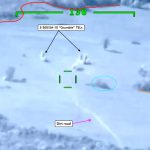The Russian-flagged “Fortuna” pipe-laying vessel has resumed work on the controversial “Nord Stream 2” pipeline on January 24. AIS trackers show Fortuna anchored 27 km south of Bornholm island (Denmark), where gaps remain in the 94%-completed pipeline.

Overview of Fortuna’s location
Owned by “KVT-RUS,” a Russian company, Fortuna has been recently sanctioned by the U.S. Department of Treasury over its involvement in the Nord Stream 2 project. Any company that does business with Fortuna or its owner, whether a port that provides servicing or an insurer, risks losing access to the U.S. financial system
Thanks to Sentinel-1’s synthetic aperture radar, we can see the ship formation through cloud cover and confirm Fortuna’s location. Dated January 24, the low-res imagery shows Fortuna positioned for pipe-laying operations and assisted by tugs, and other support vessels.

Sentinel-1 SAR shows Fortuna initiating pipe-laying operations
Fortuna left the German port of Rostock after Danish authorities cleared further constructions on Nord Stream 2 on January 15. Berlin has also greenlighted work on the pipeline in German waters.
UNSTOPPABLE
It seems that the Nord Stream 2 will go ahead despite bipartisan U.S. sanctions, criticism from Eastern European states, and even a recent resolution passed by the European Parliament that urges Brussels to halt the project. While opposition to the project grew in Germany following Navalny’s poisoning and arrest, Chancellor Merkel remains steadfast.
The German state of Mecklenburg-Vorpomman even plans to establish an “expandable” foundation to shield the companies involved in Nord Stream 2. The German foundation “for environmental protection” will absorb the heat of U.S. sanctions such as freezing assets, as it does not have commercial plans beyond the pipeline. As a result, the real stakeholders will be unharmed – at least in theory. This operation’s success will largely depend on the Biden administration’s willingness to sanction Germany over Nord Stream 2.
KEY BACKGROUND
What is Nord Stream 2?
Nord Stream 2 is a submarine pipeline that will carry natural gas from Siberia to a terminal on Germany’s Baltic sea coast. Russian energy giant Gazprom owns 50% of the pipeline. Royal Dutch Shell, Uniper SE, Engie SA, and Wintershall AG hold the rest. Nord Stream 2 is 1,200 km long and will double the throughput of Nord Stream 1.

Nord Stream 2 map (source: Gazprom)
Why did work on Nord Stream 2 stop?
U.S. sanctions temporarily froze the Nord Stream 2 pipeline. In December 2019, the Swiss company “Allseas” suspended pipe-laying operations after it came in the crosshairs of U.S. departments of State and Treasury. Since then, the Nord Stream 2 consortium has scrambled to devise countermeasures against U.S. sanctions, and searched for a new pipe-laying vessel.
The consortium contracted Fortuna and the Gazprom-owned Akademik Cherskiy” to complete the job. T-Intelligence wrote about Akademik Cherskiy’s entrance into the Baltic Sea in March 2020, after a nine-month voyage from Russia’s far east. The pipe-layer is currently docked in Wismar, Germany.
Why is Nord Stream 2 a problem?
- The project strengthens Russia’s grip on European energy. Nord Stream 2 goes against NATO’s and the European Union’s energy security policies that call for diversifying suppliers so that 30 or 27 nations are not at the mercy of one supplier. As the dominant force on Europe’s energy market, Russia has a long history of using gas exports as a tool of coercion. Gas is also a significant component of the Kremlin’s broader “hybrid warfare” strategy that aims to expand its influence using means other than military.
- It undermines Transatlantic unity. A highly divisive topic, Nord Stream 2 exacerbated existing rifts between the U.S (supported by Eastern European states) and NATO’s European core, led by Germany.
- It weakens Eastern Europe. Nord Stream 2 will reduce Russia’s dependence on Ukraine and Poland to transport gas into Europe. This could open up eastern Europe to more strong-arm tactics, including further aggression against Ukraine.
by IRT
- Russia Bombs Maternity Ward & Children’s Hospital in Mariupol As Part of Siege - 10 March 2022
- T-Intell’s OSINT Training Marks One Year Anniversary - 18 November 2021
- Russian Pipe-Layer Resumes Work on Nord Stream 2 - 25 January 2021





